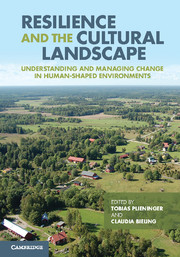 Resilience and the Cultural Landscape
Resilience and the Cultural Landscape Book contents
- Frontmatter
- Contents
- List of contributors
- Preface
- Part I Conceptualising landscapes as social–ecological systems
- 1 Connecting cultural landscapes to resilience
- 2 Landscapes as integrating frameworks for human, environmental and policy processes
- 3 From cultural landscapes to resilient social–ecological systems: transformation of a classical paradigm or a novel approach?
- 4 Conceptualising the human in cultural landscapes and resilience thinking
- 5 System or arena? Conceptual concerns around the analysis of landscape dynamics
- 6 Resilience thinking versus political ecology: understanding the dynamics of small-scale, labour-intensive farming landscapes
- Part II Analysing landscape resilience
- Part III Managing landscapes for resilience
- Part IV Perspectives for resilient landscapes
- Index
- References
2 - Landscapes as integrating frameworks for human, environmental and policy processes
Published online by Cambridge University Press: 05 November 2012
- Frontmatter
- Contents
- List of contributors
- Preface
- Part I Conceptualising landscapes as social–ecological systems
- 1 Connecting cultural landscapes to resilience
- 2 Landscapes as integrating frameworks for human, environmental and policy processes
- 3 From cultural landscapes to resilient social–ecological systems: transformation of a classical paradigm or a novel approach?
- 4 Conceptualising the human in cultural landscapes and resilience thinking
- 5 System or arena? Conceptual concerns around the analysis of landscape dynamics
- 6 Resilience thinking versus political ecology: understanding the dynamics of small-scale, labour-intensive farming landscapes
- Part II Analysing landscape resilience
- Part III Managing landscapes for resilience
- Part IV Perspectives for resilient landscapes
- Index
- References
Summary
Introduction
Although the term landscape has acquired various meanings between cultures and over the centuries (Wylie, 2007), its perceived qualities have consistently related to landform, aesthetics, history, regional identity, rules and customs. It has thus been understood as a territory, whose essence can often be apprehended in a single gaze, and possessing a distinct visual and cultural signature. Latterly, the idea of landscape has become more encompassing, as it has extended beyond the realms of aesthetics, physical geography and human geography to include ecological processes and human well-being. In this perspective, it is a physical and conceptual nexus in which many human and natural systems find their integration – it is an indivisible whole possessing intimately connected form, function and meaning.
While both natural and social scientists have long acknowledged the dynamics of cultural landscapes, public policies have tended to adopt a more static approach, either seeking to designate areas of fine scenery or to mitigate the visual impact of development. Contemporary landscape policy, however, more actively embraces ‘drivers of change’ (Schneeberger et al., 2007; Winn et al., 2011), by both promoting sustainable management of landscape per se, and influencing the practices of other landscape-producing activities such as forestry, agriculture and construction (Figure 2.1). While all landscapes are dynamic, however, their nature and pace of change differ greatly and thus they require tailored strategies reflecting a deeper understanding of where they have come from and where they are going to. For example, the European Landscape Convention (ELC) (Council of Europe, 2000) promotes strategies with different balances between ‘planning, management and protection’.
- Type
- Chapter
- Information
- Resilience and the Cultural LandscapeUnderstanding and Managing Change in Human-Shaped Environments, pp. 27 - 48Publisher: Cambridge University PressPrint publication year: 2012
References
- 3
- Cited by


